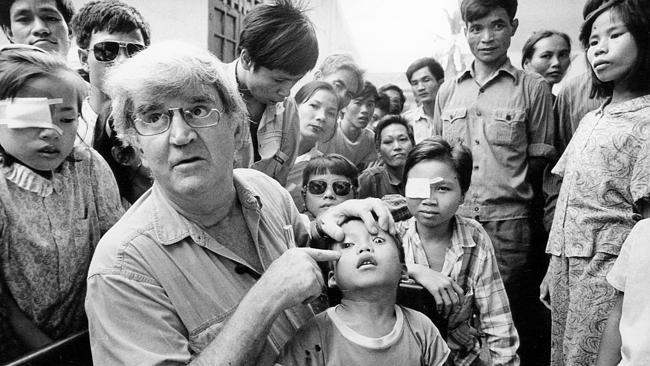Daughters finally see Fred Hollows’ miracle
IN 1991 Ruth and Rosa Hollows were infants and their father Fred had been named as The Australian’s Australian of the Year.

IN 1991 Ruth and Rosa Hollows were infants, their father Fred was named as The Australian’s Australian of the Year for the previous year, and Sanduk Ruit, a young Nepalese ophthalmologist, was living at the family’s Sydney home and learning from his older mentor.
That year also saw the legendary eye surgeon named Humanist of the Year, appointed Companion in the General Division of the Order of Australia (AC), and named as Eritrea’s first honorary citizen.
Tragically Professor Hollows would die days before his twin daughters’ third birthday, having been diagnosed with lung cancer three months before their conception.
The twins, now 24, don’t remember their father, who died aged 63 in February 1993, but as Cameron Stewart writes in Saturday’s Weekend Australian Magazine, they recently travelled to Nepal to see Hollows’s work continuing under Ruit’s stewardship, more than two decades on.
When The Australian named Hollows Australian of the Year, we noted that although he held a chair in the ophthalmology departments of UNSW and Sydney’s Prince of Wales Hospital, his most esteemed work was “conducted far from specialists’ consulting rooms and the clinics of teaching hospitals’’.
“He is noted for his practical compassionate work among Aborigines and the victims of war in Eritrea,” a front-page article in the 1991 Australia Day edition said.
The popular choice of readers and The Australian’s panel, Hollows edged out an impressive and varied list of nominees, including writer Patrick White, cricketer Sir Donald Bradman, judge Michael Kirby, entrepreneur Dick Smith, then treasurer and soon-to-be PM Paul Keating, and then NSW and Queensland premiers Nick Greiner and Wayne Goss.
Like the daughters he never lived to see grow up, Hollows laid the groundwork but did not survive to witness the success of the Fred Hollows Foundation and its two intra-ocular lens factories, built in Nepal and Eritrea to provide the means to cure blindness in more than a million people in the developing world.
Last month Stewart accompanied Ruth and Rosa, the youngest of their father’s seven children, five of whom he had with widow Gabi, on their week-long journey in Nepal to visit the Tilganga Institute of Ophthalmology and the Fred Hollows Intraocular Lens Laboratory it houses.
Hollows first met Ruit, who became his closest friend, on a trip to Nepal in 1985. He was there to assess the feasibility of a blindness prevention program in a country where 70 per cent of blindness is caused by cataracts.
Hollows’s work revolutionised the treatment of the condition in the developing world by cheaply producing the intra-ocular lenses which were previously unaffordable to most patients.
The Nepalese laboratory opened in 1994 and now produces 400,000 lenses a year for $US5 ($5.35) each, compared with $100 in the West. The lenses are exported to more than 70 African and Asian countries, and more than five million lenses have been produced by the Nepalese and Eritrean factories combined.
As Stewart explains in Saturday’s magazine piece, Ruth and Rosa had grown up knowing Ruit and hearing about the Hollows Foundation’s work in Nepal, but not visited until their recent trip.
“It’s like making sense of a story you’ve heard your whole life,” Ruth tells Stewart.



